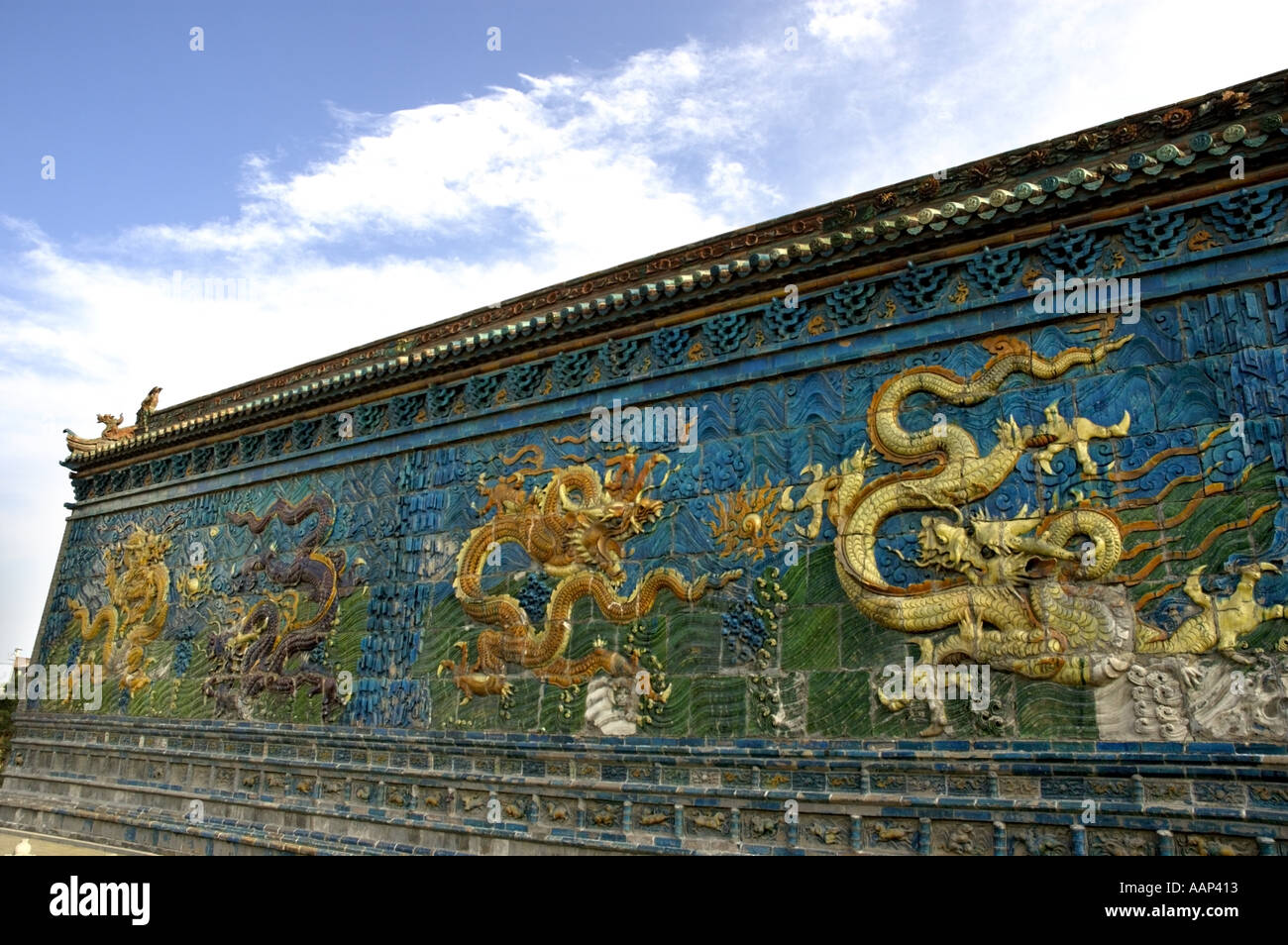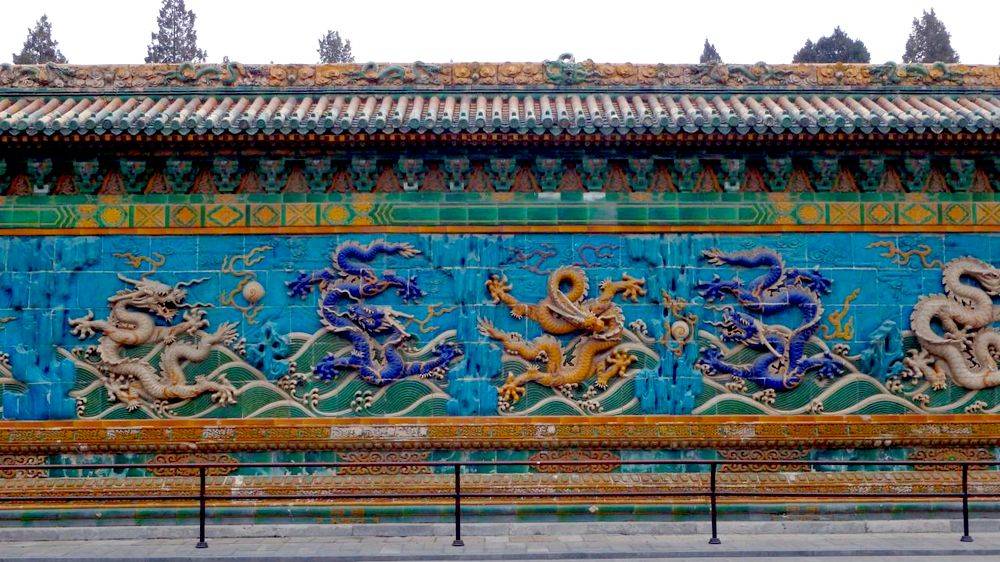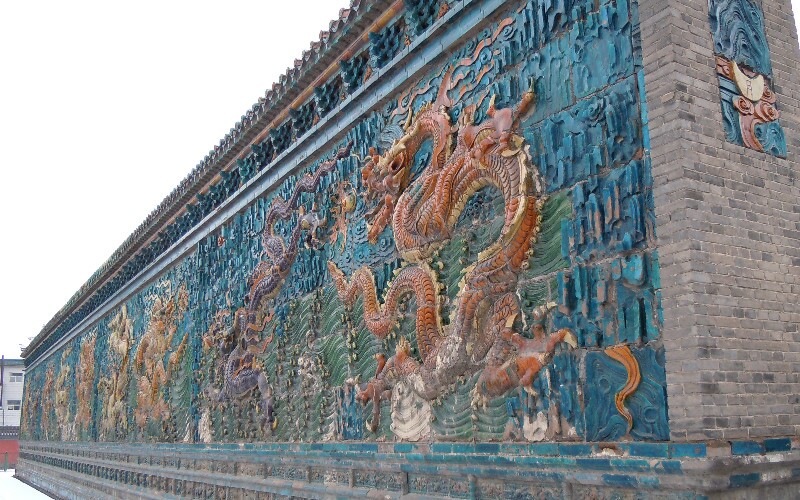What if a single work of art could encapsulate centuries of history, artistry, and cultural significance? The Nine Dragon Walls, scattered across China and beyond, offer precisely that, a testament to the enduring power of symbolism and architectural grandeur.
With origins rooted in imperial China, these magnificent structures, known as "Ji lng b" () in traditional Chinese, stand as imposing screen walls, typically adorning the entrances of palaces and gardens. They are far more than mere decorations; they are spiritual barriers, artistic masterpieces, and powerful symbols of imperial authority and good fortune. The imagery of nine dragons, each a unique creature in its own right, dancing amidst the clouds, is a visual representation of the emperor's celestial power and the auspicious blessings he bestows upon the realm. The choice of the number nine is, in itself, significant; in Chinese culture, it's considered a number imbued with magical properties and represents the Emperor's divine connection.
The Nine Dragon Walls are a breathtaking example of traditional Chinese architecture, they are not just aesthetically pleasing, but are steeped in cultural importance. The dragons, each meticulously crafted, come alive with vibrant colors, often employing yellow, the noblest color, reserved for the emperor and his court. The designs are often complex, depicting the dragons playing with pearls, symbolizing wisdom and prosperity, and the sun and moon, representing the harmonious balance of the cosmos. The placement of these walls is also carefully considered. They are invariably oriented to the north, providing protection from evil spirits and embodying the concept of feng shui, the art of harmonious spatial arrangement.
- Exploring The Life And Achievements Of Oliver Mclanahan Phillips
- Unveiling The Life Of Maureen Blumhardt A Journey Beyond The Spotlight
| Feature | Details |
|---|---|
| Name | Nine Dragon Wall (, Ji lng b) |
| Purpose | Spiritual barrier, artistic masterpiece, symbol of imperial authority and good fortune. |
| Common Location | Entrances of imperial palaces and gardens. |
| Symbolism | Nine dragons representing the emperors celestial power and good fortune; the number nine representing magical powers. |
| Design | Nine dragons often playing with pearls, with the sun and moon included, all within a sea and sky background. |
| Materials | Glazed bricks or tiles, often in seven colors. |
| Orientation | Oriented to the north. |
| Color | Yellow for the principal dragon symbolizing the Emperor. The dragons are represented in different colors. |
| Examples | Walls in Datong, Beijing, and Chicago's Chinatown. |
| Historical Context | Built across different periods of Chinese history, often in imperial contexts. |
| Reference | Wikipedia |
The city of Datong, in Shanxi Province, is home to one of the most significant examples of these walls. The Datong Nine Dragon Screen, a monumental structure built over 600 years ago, is not only the oldest but also the largest glazed screen in China today. Towering over its surroundings, it stands as a testament to the citys historical significance and artistic prowess. The screen's presence is reminiscent of the imperial court and the dragons carved into its surface, with their lifelike depictions, tell stories of power, myth, and the unwavering pursuit of perfection. As the name suggests, nine dragons are depicted, each brought to life by the use of different colored tiles, adding depth and individual meaning to each dragon.
In Beijing, the Nine Dragon Wall in Beihai Park is another remarkable example. This wall, meticulously crafted, has served as inspiration for replicas around the globe. It is an excellent example of how artists captured the essence of the imperial style with the dragons in different colors, and each dragon having its own story to tell. The central dragon, positioned at the heart of the wall, aligns with the central axis, symbolizing the primary dragon and the Emperors central role. Nine dragons, each playing with a pearl with the sun and moon aside, carved in a very lifelike manner. The use of yellow, blue, purple, and white further enlivens the writhing dragons.
Venturing beyond China, one discovers a testament to the global influence of Chinese art and culture. Several replicas of the Nine Dragon Wall have been erected in cities around the world, most notably in the Chinatowns of Chicago. The Nine Dragon Wall in Chicago's Chinatown, completed and dedicated on September 9, 2003, serves as a welcoming landmark, a vivid symbol of cultural identity. Modeled after the original in Beihai Park, the Chicago version mirrors the attention to detail and symbolism, with large dragons and hundreds of smaller ones painted in auspicious colors. This monument not only reflects the past, but it is also a symbol of strength, unity, and the continued influence of Chinese culture on a global stage.
- Exploring The Allure Of Snapchat Spotlight Nsfw
- Unveiling The Talent Of Merrin Dungey A Journey Through Film And Television
The wall in Chicago, like others, serves as a representation of the original in the Beihai (North Sea) Park in Beijing. Nine large dragons and 500+ smaller dragons are painted in red, gold, and blue, colors that in Chinese culture are connected to good fortune. This replicated wall serves as an entrance to Chinatown and has been a symbol of the Chinese population in Chicago. These replicas are not merely copies; they are symbols of cultural continuity, diaspora identity, and a bridge between the past and the present.
The creation of these majestic structures involved considerable effort. The Datong Nine Dragon Screen, which was constructed of glazed bricks, stands out due to its remarkable size and the skill of the artisans who created it. Similarly, the construction of the Nine Dragon Wall in the imperial palace required intricate planning. The meticulous arrangement of the bricks, the vibrant colors, and the exquisite detail of the dragon carvings required immense precision and artistic mastery. The fact that these walls have survived for centuries, enduring the effects of time, stands as a testament to the durability and genius of the ancient builders.
The "spirit wall" is a term used to describe these nine-dragon walls, indicating their role in protecting a local palace. The dragons depicted on the wall were made from different color tiles, each representing a unique meaning. They represent the power and protection the palace has in order to keep the emperor safe. The dragon in the middle is the principal dragon, while those on either side are ascending dragons and descending dragons respectively.The principal dragon is in yellow, which is the noblest color, so emperors robes were yellow.
The symbolism of the Nine Dragon Walls goes far beyond their aesthetic appeal. In Chinese culture, the dragon is a revered symbol, embodying power, strength, and good fortune. The number nine is considered auspicious, associated with heavenly powers and the emperor's connection to the divine. In the creation of the Nine Dragon Walls, these symbols are incorporated and represent a variety of cultural values and aspirations, including the pursuit of prosperity, the preservation of order, and respect for tradition.
The design and construction of the Nine Dragon Walls also speak volumes about the values and artistic traditions of the Chinese civilization. Each wall is a product of meticulous planning, sophisticated technology, and artistic execution. The use of glazed bricks in various colors, the precise carving of the dragons, and the placement of the walls according to principles of feng shui all reflect the Chinese people's deep appreciation of harmony, symmetry, and the union of the physical and spiritual worlds. The construction of these walls involved a great deal of skill and knowledge, which are still admired and respected today.
The Nine Dragon Walls are not merely relics of the past; they remain a source of inspiration and beauty. They have been relocated and reconstructed over time, with each instance demonstrating the cultural values and the ingenuity of the Chinese people. The walls stand as a testament to the enduring legacy of traditional Chinese art and architecture, continuing to inspire visitors and viewers from all over the world.
The Nine Dragon Walls continue to be valuable cultural heritage. They provide a window into the past, educating us about the rich history, customs, and beliefs of the Chinese civilization. They also provide chances for cultural exchange and promote understanding between different cultures, whether in China or the Chinatowns across the globe. Through these walls, we come to know the meaning of art, history, and culture and how these aspects are intertwined with Chinese values and traditions.
In the intricate details of the dragons, the carefully selected colors, and the overall composition of each Nine Dragon Wall, one can discern the essence of Chinese culture, offering a glimpse into a world where art, spirituality, and power intertwine. They provide not just a view of the past but an appreciation of the present and inspiration for the future. In the shadow of the Nine Dragon Walls, we are reminded that great art transcends time, cultures, and boundaries, making us think and admire for generations to come.
- Unveiling The Talent Of Merrin Dungey A Journey Through Film And Television
- Shiloh Joliepitt A Glimpse Into The Life Of A Rising Star


